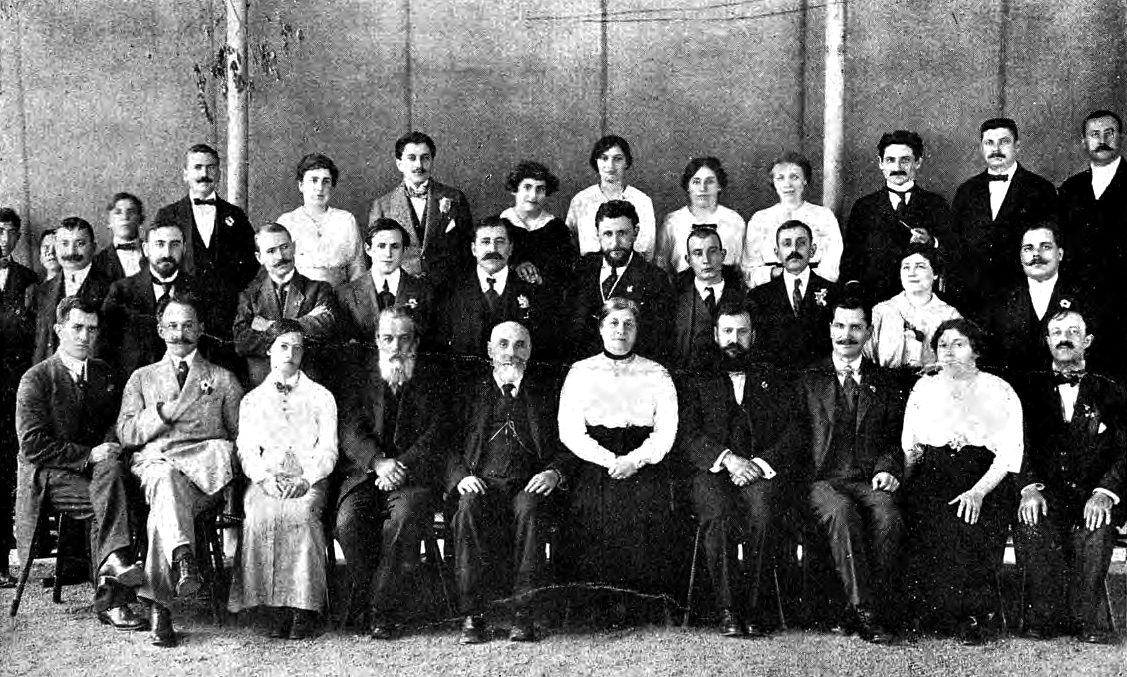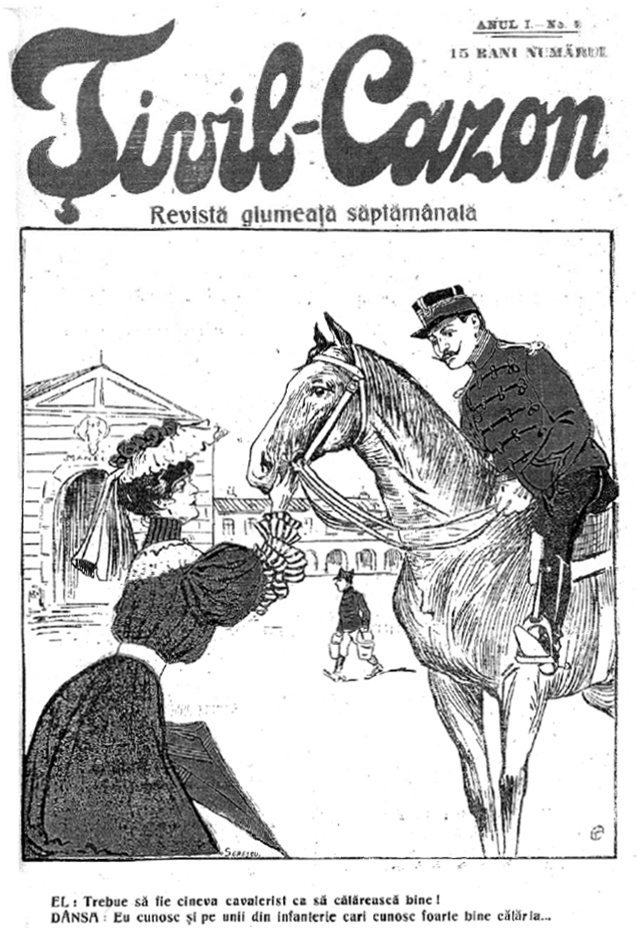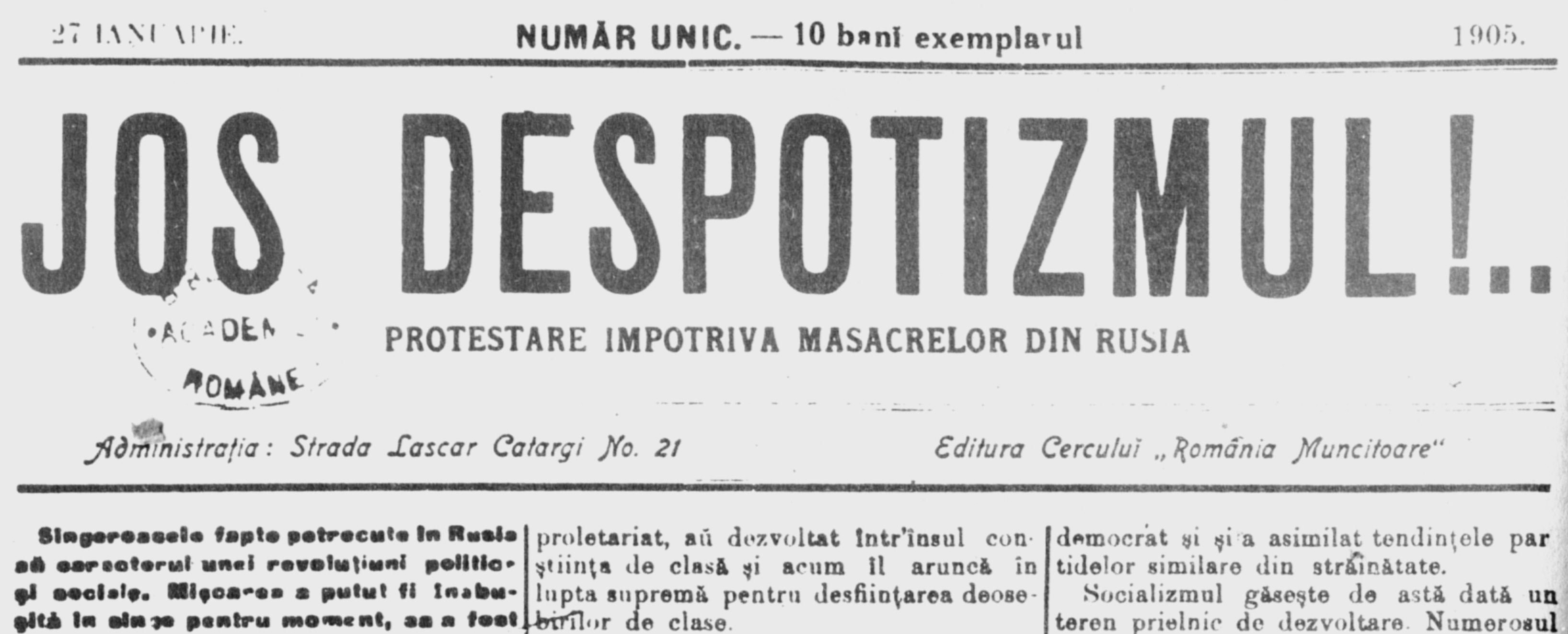|
Ottoi Călin
Ottoi Călin (March 1886 – 1 April 1917) was a Romanian physician, journalist and socialist militant, considered one of the theoreticians of the Romanian workers' movement during the early 20th century. Early life and education Călin was born in a poor Jewish family in Iași, in north-eastern Romania. After finishing high school, he obtained a medical degree from the local university. During his teen years, along with other young students, he frequented the ''Circle of Social Studies'' organized by socialists Leon Ghelerter and Max Vexler. The ''Circle'', the main left-wing association in Moldavia at the time, played a major role in shaping future leaders of the Romanian socialist movement, such as Mihail Gheorghiu Bujor and Ilie Moscovici. Beside participating in the ''Circle'', Călin lectured on natural and social sciences for a local adult school. Beginning with 1908, he published regularly in the '' Viitorul Social'' magazine, with his articles targeting primarily theor ... [...More Info...] [...Related Items...] OR: [Wikipedia] [Google] [Baidu] |
Iași
Iași ( , , ; also known by other alternative names), also referred to mostly historically as Jassy ( , ), is the second largest city in Romania and the seat of Iași County. Located in the historical region of Moldavia, it has traditionally been one of the leading centres of Romanian social, cultural, academic and artistic life. The city was the capital of the Principality of Moldavia from 1564 to 1859, then of the United Principalities from 1859 to 1862, and the capital of Romania from 1916 to 1918. Known as the Cultural Capital of Romania, Iași is a symbol of Romanian history. Historian Nicolae Iorga stated that "there should be no Romanian who does not know of it". Still referred to as "The Moldavian Capital", Iași is the main economic and business centre of Romania's Moldavian region. In December 2018, Iași was officially declared the Historical Capital of Romania. At the 2011 census, the city-proper had a population of 290,422 (making it the fourth most populous in ... [...More Info...] [...Related Items...] OR: [Wikipedia] [Google] [Baidu] |
Scientific Socialism
Scientific socialism is a term coined in 1840 by Pierre-Joseph Proudhon in his book ''What is Property?'' to mean a society ruled by a scientific government, i.e., one whose sovereignty rests upon reason, rather than sheer will: Thus, in a given society, the authority of man over man is inversely proportional to the stage of intellectual development which that society has reached; and the probable duration of that authority can be calculated from the more or less general desire for a true government, — that is, for a scientific government. And just as the right of force and the right of artifice retreat before the steady advance of justice, and must finally be extinguished in equality, so the sovereignty of the will yields to the sovereignty of the reason, and must at last be lost in scientific socialism. In the 1844 book '' The Holy Family'', Karl Marx and Friedrich Engels described the writings of the socialist, communist writers Théodore Dézamy and Jules Gay as truly "scie ... [...More Info...] [...Related Items...] OR: [Wikipedia] [Google] [Baidu] |
Bucharest
Bucharest ( , ; ro, București ) is the capital and largest city of Romania, as well as its cultural, industrial, and financial centre. It is located in the southeast of the country, on the banks of the Dâmbovița River, less than north of the Danube River and the Bulgarian border. Bucharest was first mentioned in documents in 1459. The city became the capital of Romania in 1862 and is the centre of Romanian media, culture, and art. Its architecture is a mix of historical (mostly Eclectic, but also Neoclassical and Art Nouveau), interbellum ( Bauhaus, Art Deco and Romanian Revival architecture), socialist era, and modern. In the period between the two World Wars, the city's elegant architecture and the sophistication of its elite earned Bucharest the nickname of 'Paris of the East' ( ro, Parisul Estului) or 'Little Paris' ( ro, Micul Paris). Although buildings and districts in the historic city centre were heavily damaged or destroyed by war, earthquakes, and even Nic ... [...More Info...] [...Related Items...] OR: [Wikipedia] [Google] [Baidu] |
Pacifism
Pacifism is the opposition or resistance to war, militarism (including conscription and mandatory military service) or violence. Pacifists generally reject theories of Just War. The word ''pacifism'' was coined by the French peace campaigner Émile Arnaud and adopted by other peace activists at the tenth Universal Peace Congress in Glasgow in 1901. A related term is '' ahimsa'' (to do no harm), which is a core philosophy in Indian Religions such as Hinduism, Buddhism, and Jainism. While modern connotations are recent, having been explicated since the 19th century, ancient references abound. In modern times, interest was revived by Leo Tolstoy in his late works, particularly in '' The Kingdom of God Is Within You''. Mahatma Gandhi propounded the practice of steadfast nonviolent opposition which he called " satyagraha", instrumental in its role in the Indian Independence Movement. Its effectiveness served as inspiration to Martin Luther King Jr., James Lawson, Mary and Cha ... [...More Info...] [...Related Items...] OR: [Wikipedia] [Google] [Baidu] |
Jean Jaurès
Auguste Marie Joseph Jean Léon Jaurès (3 September 185931 July 1914), commonly referred to as Jean Jaurès (; oc, Joan Jaurés ), was a French Socialist leader. Initially a Moderate Republican, he later became one of the first social democrats and (in 1902) the leader of the French Socialist Party, which opposed Jules Guesde's revolutionary Socialist Party of France. The two parties merged in 1905 in the French Section of the Workers' International (SFIO). An antimilitarist, Jaurès was assassinated in 1914 at the outbreak of World War I, but remains one of the main historical figures of the French Left. As a heterodox Marxist, Jaurès rejected the concept of the dictatorship of the proletariat and tried to conciliate idealism and materialism, individualism and collectivism, democracy and class struggle, patriotism and internationalism. Early career The son of an unsuccessful businessman and farmer, Jean Jaurès was born in Castres, Tarn, into a modest French pr ... [...More Info...] [...Related Items...] OR: [Wikipedia] [Google] [Baidu] |
French Section Of The Workers' International
The French Section of the Workers' International (french: Section française de l'Internationale ouvrière, SFIO) was a political party in France that was founded in 1905 and succeeded in 1969 by the modern-day Socialist Party. The SFIO was founded during the 1905 Globe Congress in Paris as a merger between the French Socialist Party and the Socialist Party of France in order to create the French section of the Second International, designated as the party of the workers' movement. The SFIO was led by Jules Guesde, Jean Jaurès (who quickly became its most influential figure), Édouard Vaillant and Paul Lafargue (Karl Marx's son in law), and united the Marxist tendency represented by Guesde with the social-democratic tendency represented by Jaurès. The SFIO opposed itself to colonialism and to militarism, although the party abandoned its anti-militarist views and supported the national union government (french: link=no, Union nationale) facing Germany's declaration of war on F ... [...More Info...] [...Related Items...] OR: [Wikipedia] [Google] [Baidu] |
Barbu Lăzăreanu
Barbu Lăzăreanu (born Avram Lazarovici,Valentin Chifor, "Lăzăreanu Barbu", in Aurel Sasu (ed.), ''Dicționarul biografic al literaturii române'', Vol. I, pp. 839–840. Pitești: Editura Paralela 45, 2004. or Bercu Leizerovici,Constantin Iordăchescu, "Intre Pușchin și profetul Isaia", in '' Cuget Clar'', Vol. I, 1936–1937, p. 720 also known as Barbou Lazareano Pompiliu Păltânea, "Lettres roumaines", in ''Mercure de France'', Issue 627, August 1924, p. 818 or Barbu Lăzărescu;Straje, pp. 390, 391 October 5, 1881 – January 19, 1957) was a Romanian literary historian, bibliographer, and left-wing activist. Of Romanian Jewish background, he became noted for both his social criticism and his lyrical pieces while still in high school, subsequently developing as a satirist and printing his own humorous magazine, ''Țivil-Cazon''. Lăzăreanu's youthful sympathies veered toward the anarchist underground, prompting him to associate with Panait Mușoiu. At that stage of his ... [...More Info...] [...Related Items...] OR: [Wikipedia] [Google] [Baidu] |
Ioan Sion (politician)
Alecu Ioan Sion (September 28, 1890 – November 24, 1942) was a Romanian soldier and a major general in the Land Forces. Born in Pitești, he attended the military high school from Iași and then studied at the military school for artillery and engineers officers in Bucharest from 1909 to 1911. He entered the army as a second lieutenant in 1911. Promoted to lieutenant in 1914, he later took part in World War I, commanding a unit within the 2nd Artillery Regiment. During the Romanian Campaign of 1916, he stood out at the battles of Perșani and Porumbacu, for which he was awarded the Order of the Crown of Romania, Knight class. He was promoted to captain in 1917, and fought in the battles in Moldavia during that summer. After the war, Sion advanced in rank to major in January 1921, and then attended the Higher War School from November 1921 to October 1923. He became a lieutenant colonel in 1931 and a colonel in 1937. He commanded the center for artillery instruction be ... [...More Info...] [...Related Items...] OR: [Wikipedia] [Google] [Baidu] |
Christian Rakovsky
Christian Georgievich Rakovsky (russian: Христиа́н Гео́ргиевич Рако́вский; bg, Кръстьо Георги́ев Рако́вски; – September 11, 1941) was a Bulgarian-born socialist revolutionary, a Bolshevik politician and Soviet diplomat and statesman; he was also noted as a journalist, physician, and essayist. Rakovsky's political career took him throughout the Balkans and into France and Imperial Russia; for part of his life, he was also a Romanian citizen. A lifelong collaborator of Leon Trotsky, he was a prominent activist of the Second International, involved in politics with the Bulgarian Workers' Social Democratic Party, Romanian Social Democratic Party, and the Russian Social Democratic Labour Party. Rakovsky was expelled at different times from various countries as a result of his activities, and, during World War I, became a founding member of the Revolutionary Balkan Social Democratic Labor Federation while helping to organize ... [...More Info...] [...Related Items...] OR: [Wikipedia] [Google] [Baidu] |
Paris
Paris () is the capital and most populous city of France, with an estimated population of 2,165,423 residents in 2019 in an area of more than 105 km² (41 sq mi), making it the 30th most densely populated city in the world in 2020. Since the 17th century, Paris has been one of the world's major centres of finance, diplomacy, commerce, fashion, gastronomy, and science. For its leading role in the arts and sciences, as well as its very early system of street lighting, in the 19th century it became known as "the City of Light". Like London, prior to the Second World War, it was also sometimes called the capital of the world. The City of Paris is the centre of the Île-de-France region, or Paris Region, with an estimated population of 12,262,544 in 2019, or about 19% of the population of France, making the region France's primate city. The Paris Region had a GDP of €739 billion ($743 billion) in 2019, which is the highest in Europe. According to the Economist Intelli ... [...More Info...] [...Related Items...] OR: [Wikipedia] [Google] [Baidu] |
Berlin
Berlin ( , ) is the capital and largest city of Germany by both area and population. Its 3.7 million inhabitants make it the European Union's most populous city, according to population within city limits. One of Germany's sixteen constituent states, Berlin is surrounded by the State of Brandenburg and contiguous with Potsdam, Brandenburg's capital. Berlin's urban area, which has a population of around 4.5 million, is the second most populous urban area in Germany after the Ruhr. The Berlin-Brandenburg capital region has around 6.2 million inhabitants and is Germany's third-largest metropolitan region after the Rhine-Ruhr and Rhine-Main regions. Berlin straddles the banks of the Spree, which flows into the Havel (a tributary of the Elbe) in the western borough of Spandau. Among the city's main topographical features are the many lakes in the western and southeastern boroughs formed by the Spree, Havel and Dahme, the largest of which is Lake Müggelsee. Due to its l ... [...More Info...] [...Related Items...] OR: [Wikipedia] [Google] [Baidu] |





